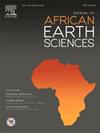Application of petrography, geochemistry and palynology of the mid-Ordovician – Pennsylvanian sediments of Tabenken in the investigation of Palaeo-environmental alterations of the Oku massif, North West Cameroon
IF 2.2
4区 地球科学
Q2 GEOSCIENCES, MULTIDISCIPLINARY
引用次数: 0
Abstract
This study is effected on the volcano-sedimentary terrain of Tabenken on the Oku massif. Here is a region predominantly underlain by a granitoid basement of Precambrian age (600 ma), overlain in most parts by alkali basalts, andesites, trachytes and rhyolites. Between the basement and volcanics is sandwiched a discontinuous sequence of sedimentary lithofacies composed of conglomerates, sandstones, claystones, siltstones and patches of coal raising the question of the palaeoenvironment. Petrographic analyses, major and trace element geochemistry and palynological analyses were conducted on samples of sediments. Palynological constituents found include amorphous organic matter, phytoclasts, opaque material and palynomorphs consisting of spores with no pollen grains. The presence of cuticles is environmental indicator for delta sediments while abundance of amorphous organic matter (AOM) suggests deposition in a reducing environment. Petrographic studies reveal two cycles of deposition; L1 and L2 separated by Cenozoic outpours. U/Th ratios for the analyzed samples range from 0.3, 0.06, 0.00 to 0.2 and fall within the range of sediments formed in oxidizing environments. This contrasts evidence from AOM hence suggests sediment input cut across climatic and environmental alterations over a long period of time. Sr/Ba ratios range from 0.08 to 0.25 with an average of 0.18 reflecting fresh water environment; while Rb/Sr ratios range from 0.2, 0.29, 0.33 and 0.45 being low and suggests sediments deposited under warm climatic conditions. Diagram of Roser and Korsch, 1986 reveals deposition in a passive margin while Al2O3/TiO2 and Th/Co ratios support sediment input of principally felsic origin with little input from mafic sources.
塔本肯中奥陶世-宾夕法尼亚沉积物的岩石学、地球化学和古植物学在喀麦隆西北部奥库地块古环境变化调查中的应用
这项研究的对象是奥丘陵地塔本肯(Tabenken)的火山沉积地形。该地区主要由前寒武纪(600ma)的花岗岩基底所覆盖,大部分地区被碱性玄武岩、安山岩、闪长岩和流纹岩所覆盖。基底和火山岩之间夹着不连续的沉积岩体序列,由砾岩、砂岩、粘土岩、粉砂岩和成片的煤组成,引发了古环境问题。对沉积物样本进行了岩相分析、主要元素和微量元素地球化学分析以及古植物学分析。发现的古动物学成分包括无定形有机物、植物角质层、不透明物质和由孢子(无花粉粒)组成的古动物形态。角质层的存在是三角洲沉积物的环境指标,而大量的无定形有机物(AOM)则表明沉积在还原环境中。岩相学研究揭示了两个沉积周期:L1 和 L2,它们被新生代的出露所分隔。分析样品的 U/Th 比率范围为 0.3、0.06、0.00 至 0.2,属于氧化环境中形成的沉积物的范围。这与 AOM 的证据形成鲜明对比,表明沉积物的输入跨越了漫长的气候和环境变化时期。硒/钡比值在 0.08 至 0.25 之间,平均值为 0.18,反映了淡水环境;而铷/硒比值在 0.2、0.29、0.33 和 0.45 之间,偏低,表明沉积物是在温暖的气候条件下沉积的。Roser 和 Korsch,1986 年的图表显示沉积在被动边缘,而 Al2O3/TiO2 和 Th/Co 比率则表明沉积物主要来自长英岩,很少来自黑云母。
本文章由计算机程序翻译,如有差异,请以英文原文为准。
求助全文
约1分钟内获得全文
求助全文
来源期刊

Journal of African Earth Sciences
地学-地球科学综合
CiteScore
4.70
自引率
4.30%
发文量
240
审稿时长
12 months
期刊介绍:
The Journal of African Earth Sciences sees itself as the prime geological journal for all aspects of the Earth Sciences about the African plate. Papers dealing with peripheral areas are welcome if they demonstrate a tight link with Africa.
The Journal publishes high quality, peer-reviewed scientific papers. It is devoted primarily to research papers but short communications relating to new developments of broad interest, reviews and book reviews will also be considered. Papers must have international appeal and should present work of more regional than local significance and dealing with well identified and justified scientific questions. Specialised technical papers, analytical or exploration reports must be avoided. Papers on applied geology should preferably be linked to such core disciplines and must be addressed to a more general geoscientific audience.
 求助内容:
求助内容: 应助结果提醒方式:
应助结果提醒方式:


